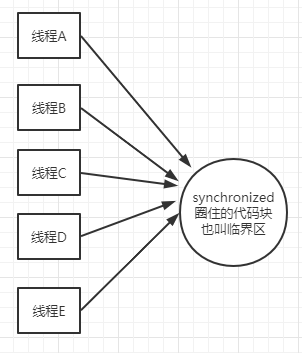写这篇文章之前,我去百度了一下啥叫锁,百度百科上写道:置于可启闭的器物上,以钥匙或暗码开启。确实我们一般理解的锁就是门锁,密码锁,但是在计算机科学中,锁又是啥,说实话,这个问题我也思考了很久,也没法很好的用一两句话就让人听得明白,也不想有人看到我的文章,然后将我的结论当作答案,我觉得最好的答案还是在探索的过程中得到的,接下来我们就好好探索一番。
作为一名java程序员,最开始接触到的锁就是synchronized,书本上是这么写的,老师也是这么说的,至于为啥叫锁,可能也没多少人真的去思考过。不知道有没有同学和我一样,经历过只知道用synchronized,后来逐渐的了解ReentrantLock,读写锁,然后又了解了aqs,后来通过百度google,看一些博客(这个我要吐槽一下,在学习过程中遇到过很多文章写的有问题的,反而误导了我),后面看了看synchronized的源码,最后对比synchronized和ReentrantLock才加深了对锁的一些认知(说实话,作为一个刚毕业3年的非科班出身码农,我也不敢保证自己写的就一定对,算是学习过程中的一些感悟吧),那接下来我就按照学习顺序来逐渐展开。
先来一段简单的synchronized使用代码:
public static void main(String[] args) { String s = new String(); synchronized (s) { TestJni jni = new TestJni(); jni.jniHello(); } }
上面代码做的事情很简单,如下图所示,有A B C D E多个线程同时来到synchronized包含的代码块,A先一步进来了,那么BCDE都得等,等我A执行完他们才能进来执行。


synchronized用起来确实很简单,我们也可以放在方法上,但是其本质还是锁的对象,这个我们后面分析源码一看就知道了。
随着开发时间越长,synchronized在有些复杂场景下(如需要可中断,可控制时间抢锁,需要多个等待队列分别控制,读写锁等场景的时候)无法满足我们的需求,那么就要用到Lock,下面我们先介绍一下Lock的简单使用:
Lock lock = new ReentrantLock(); lock.lock(); try { System.out.println("线程:"+Thread.currentThread().getName()+ " 进来啦"); }finally { lock.unlock(); }
上面是一种最简单的使用,和synchronized作用是一样的,不过加锁之后必须要解锁,且必须紧跟try - finally块解锁,使用起来稍微复杂一点,容易出错。
我们再介绍一种可中断的使用方式:
public static void main(String[] args) { Thread thread = new Thread(() -> { try { lock.lockInterruptibly(); try { testLock(); } finally { lock.unlock(); } } catch (Exception e){ } }); thread.start(); thread.interrupt(); } public static void testLock(){ condition.signalAll(); System.out.println("线程:"+Thread.currentThread().getName()+ " 进来啦"); }
这种方式呢,在拿锁被park住了,如果刚好这时候被打断了,就会响应打断退出抢锁并抛出异常,至于捕获到异常开发者怎么做,那就得根据业务来分别处理了。
而像可控制时间的其实就要稍微复杂一点,先看一下synchronized中的使用:
static TestHash s = new TestHash(); public static void main(String[] args) { Thread thread1 = new Thread(()->{ testLock(); }); Thread thread2 = new Thread(()->{ synchronized (s) { try { TimeUnit.SECONDS.sleep(1); } catch (InterruptedException e) { } s.notify(); testLock(); } }); thread1.start(); thread2.start(); } public static void testLock(){ synchronized (s) { System.out.println("线程:"+Thread.currentThread().getName()+ " 进来啦"); try { s.wait(); System.out.println("线程:"+Thread.currentThread().getName()+ " 叫醒啦"); } catch (InterruptedException e) { System.out.println("抛异常啦"); } } }
这个例子看着要比前面几个复杂一点,首先thread1会进入testLock方法,并拿到锁,thread2等了1秒叫醒thread1(这里就是简单的wait/notify的使用),然后在拿到锁的情况下,再次进入testLock方法并拿到锁,由于没人唤醒了,会一直卡在这里(这里证明了synchronized的可重入),结果我就不贴了,感兴趣的可以拿着代码去试。
而ReentrantLock的使用也差不多,就是提前用lock去new一个Condition:
static ReentrantLock lock = new ReentrantLock(); static Condition condition = lock.newCondition(); public static void main(String[] args) { Thread thread1 = new Thread(()->{ testWaitSingal(); },"thread1"); Thread thread2 = new Thread(()->{ lock.lock(); try { TimeUnit.SECONDS.sleep(1); condition.signal(); testWaitSingal(); } catch (InterruptedException e) { }finally { lock.unlock(); } },"thread2"); thread1.start(); thread2.start(); } public static void testWaitSingal(){ lock.lock(); try { System.out.println("线程:"+Thread.currentThread().getName()+ " 进来啦"); condition.await(); System.out.println("线程:"+Thread.currentThread().getName()+ " 叫醒啦"); } catch (InterruptedException e) { System.out.println("抛异常啦"); }finally { lock.unlock(); } }
可以看到两种用法基本上是一致的,也就是将synchronized换成了lock,wait换成await,notify换成singal,
总结:
基本上我们平时用到的synchronized关键字的用法也就这些,但lock锁不一样,它还支持如上述的中断,更复杂的读写锁,还可以在aqs的基础上衍生出更多,如countDownLatch,cyclicBarrier等,可以支持我们做更多,但是不是lock就可以完全替代synchronized了呢,其实synchronized也有自己的优点,简单,不易出错,性能也不比lock差(有的书上写道synchronized性能比lock好,但其实就算好也不会好太多,对于我们来说,基本上可以忽略),真要说选哪个,我的建议是优先选synchronized,如果有特殊业务特殊需求synchronized无法满足,那当然是要用lock,不过,一定要记得释放锁哦。
本来打算结合reentrant和synchronized直接串起来讲的,但是确实有点多,这一篇就当作是后面的引子吧。